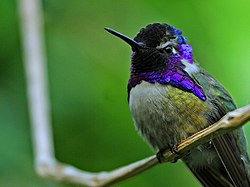| Costa's hummingbird | |
|---|---|
 | |
 | |
| Male above, female below | |
| Scientific classification | |
| Kingdom: | Animalia |
| Phylum: | Chordata |
| Class: | Aves |
| Clade: | Strisores |
| Order: | Apodiformes |
| Family: | Trochilidae |
| Genus: | Calypte |
| Species: | C. costae |
| Binomial name | |
| Calypte costae (Bourcier, 1839) | |
 | |
| Range of C. costae Breeding range Year-round range Wintering range | |
Costa's hummingbird ( Calypte costae) is a species of hummingbird in the family Trochilidae. [3] It breeds in the arid, semi-arid and Mediterranean climate zones of the Southwestern United States and northwestern Mexico, mainly in Southern California and the Baja California Peninsula. Like many hummingbirds in the region, it can be found on the Pacific coast, often visiting backyard hummingbird feeders and gardens with flowering plants, as well as in more wild ecosystems, such as the conifer and oak forests, chaparral, and high desert habitats found further inland. When not in the US, the species often winters in western Mexico. [3]



